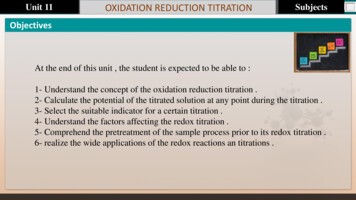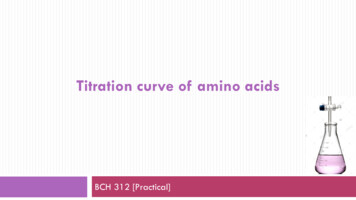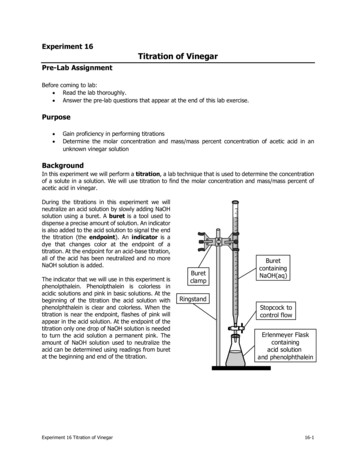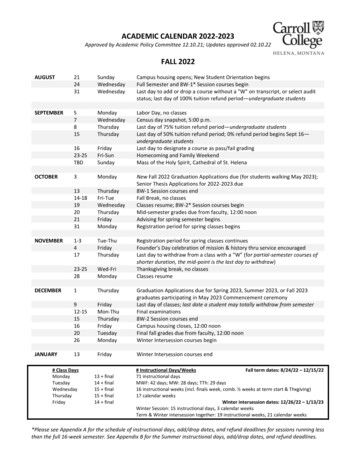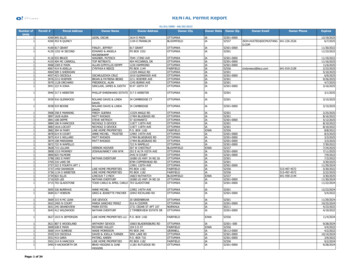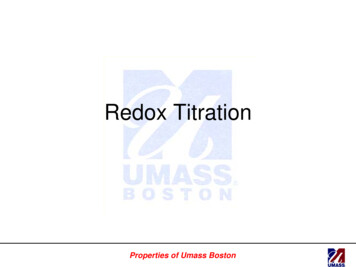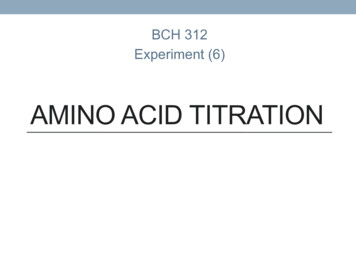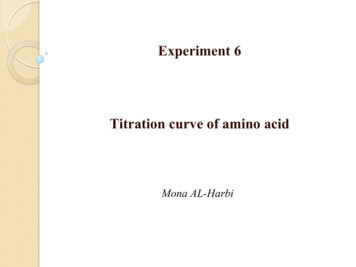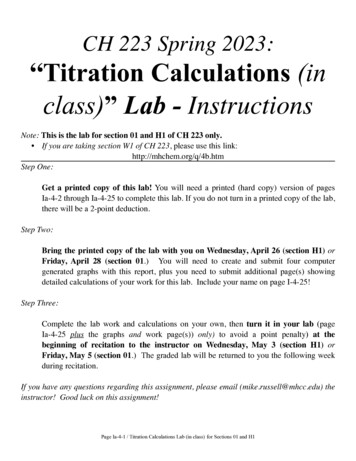
Transcription
CH 223 Spring 2023:“Titration Calculations (inclass)” Lab - InstructionsNote: This is the lab for section 01 and H1 of CH 223 only. If you are taking section W1 of CH 223, please use this link:http://mhchem.org/q/4b.htmStep One:Get a printed copy of this lab! You will need a printed (hard copy) version of pagesIa-4-2 through Ia-4-25 to complete this lab. If you do not turn in a printed copy of the lab,there will be a 2-point deduction.Step Two:Bring the printed copy of the lab with you on Wednesday, April 26 (section H1) orFriday, April 28 (section 01.) You will need to create and submit four computergenerated graphs with this report, plus you need to submit additional page(s) showingdetailed calculations of your work for this lab. Include your name on page I-4-25!Step Three:Complete the lab work and calculations on your own, then turn it in your lab (pageIa-4-25 plus the graphs and work page(s)) only) to avoid a point penalty) at thebeginning of recitation to the instructor on Wednesday, May 3 (section H1) orFriday, May 5 (section 01.) The graded lab will be returned to you the following weekduring recitation.If you have any questions regarding this assignment, please email (mike.russell@mhcc.edu) theinstructor! Good luck on this assignment!Page Ia-4-1 / Titration Calculations Lab (in class) for Sections 01 and H1
Acid and Base Titrations - Equation GuideStrong Acid Strong Base: (SA SB)Initial Region:pH - log (nsa / Vsa)Pre-Equivalence Region: pH -logEquivalence:nsa nsb( Vsa Vsb )or pH - log (Csa)or pH -lognsa nsb( Vtotal )pH 7Post-Equivalence Region: pH 14 lognsb nsa( Vsa Vsb )or pH 14 lognsb nsa( Vtotal )Strong Base Strong Acid: (SB SA)Initial Region:pH 14 log (nsb / Vsb)Pre-Equivalence Region: pH 14 logEquivalence:nsb nsa( Vsa Vsb )or pH 14 log (Csb)or pH 14 lognsb nsa( Vtotal )pH 7Post-Equivalence Region: pH -lognsa nsb( Vsa Vsb )or pH -lognsa nsb( Vtotal )Weak Acid Strong Base: (WA SB)Initial Region:pH -logKa Pre-Equivalence Region: pH pKa logn waVwaor pH -log Ka Cwansb( n wa nsb )Half-Equivalence Region: pH pKaEquivalence:pH 14 logPost-Equivalence Region: pH 14 logKwn wa Ka (Vwa Vsb)nsb n wa( Vsb Vwa )or pH 14 log Kb Cwbor pH 14 logContinued on next pagePage Ia-4-2 / Titration Calculations Lab (in class) for Sections 01 and H1nsb n wa( Vtotal )
Weak Base Strong Acid: (WB SA)Initial Region:pH 14 logPre-Equivalence Region: pH pKa logKb n wbVwbor pH 14 log Kb Cwbn wb nsa( nsa )Half-Equivalence Region: pH pKaEquivalence:pH -logPost-Equivalence Region: pH -logKwn wb Kb (Vwb Vsa)nsa n wb( Vsa Vwb )or pH -log Ka Cwaor pH -lognsa n wb( Vtotal )Guide to Symbolsn molesV volume (L)C concentration (M or mol/L)sa strong acidsb strong basewa weak acidwb weak baseKa acid dissociation constant for a weak acidpKa - log KaKa 10-pKaKb base dissociation constant for a weak basepKb - log KbKb 10-pKbKw 10-14 autoionization constant for water at 25 CAlso, Kw [H3O ]*[OH-] Ka*Kb 10-14pH - log [H3O ]pOH - log [OH-]14 pH pOH pKa pKbPage Ia-4-3 / Titration Calculations Lab (in class) for Sections 01 and H1
Strong Acid Strong Base Titration - Overview141210post-equivalence (n sb nsa)8pHequivalence (nsa nsb), pH 764pre-equivalence (n sa nsb)initial (only nsa)2001020404548495051556080100V o l um e (m L)Page Ia-4-4 / Titration Calculations Lab (in class) for Sections 01 and H1
Strong Base Strong Acid Titration - Overviewinitial (only nsb)1412pre-equivalence (n sb nsa)108pHequivalence (nsb nsa), pH 76post-equivalence (n sa nsb)42001020404950516080100V o l um e (m L)Page Ia-4-5 / Titration Calculations Lab (in class) for Sections 01 and H1
Weak Acid Strong Base Titration - Overview14post-equivalence(nsb nwa)1210equivalence(nwa nsb)pH 7pH86pre-equivalence(nwa nsb)pKa4half-equivalence2initial (only nwa)0051015202530V o l um e (m L)Page Ia-4-6 / Titration Calculations Lab (in class) for Sections 01 and H135s
Weak Base Strong Acid Titration - OverviewPage Ia-4-7 / Titration Calculations Lab (in class) for Sections 01 and H1
CH 223 Guide to Acid and Base Titration CalculationsAcid and base titrations can be a challenging concept for students to conquer in CH 223. This handoutwill help prepare you for the types of problems associated with titrations.A titration is an experimental procedure whereby a solution (usually either acidic or basic) is addeddropwise to a second solution (usually either acidic or basic.) One solution will be acidic while the other willbe basic. The solution that is added dropwise is called the titrant. Titrations are often graphed using pH as they-axis and Volume of Titrant (mL) as the x-axis. Sometimes a second y-axis is used to plot the firstderivative; we shall explore this concept in the labs during CH 223.pH is defined as the negative log of the hydronium concentration, i.e. pH - log [H3O ]. All of thecalculations given below reflect this basic idea. Values of pH less than seven indicate acidic conditions, whilepH values greater than seven indicate basic conditions; a pH reading of 7 is neutral (neither acidic nor basic).Weak acids, weak bases, strong acids and strong bases require different formulas to find the concentration of[H3O ]; hence, there are different mathematical approaches to titrations depending on the substituents beingtitrated. We shall concern ourselves only with monoprotic acids and bases - those that have only oneequivalent of H3O or OH- to offer.We will study four monoprotic titration combinations: Strong acid titrated with strong base: the pH is initially acidic but becomes more basic asthe strong base titrant is added Strong base titrated with strong acid: the pH is initially basic but becomes more acidic asthe strong acid titrant is added Weak acid titrated with strong base: the pH is initially somewhat acidic but becomesmore basic as the strong base titrant is added Weak base titrated with strong acid: the pH is initially somewhat basic but becomes moreacidic as the strong acid titrant is addedWeak acid weak base titration combinations require an intensive analysis of Ka and Kb constants andare of limited versatility; hence, we will cover only the first four types of titrations.Before you begin calculations for any titration in CH 223, do the following:1)2)3)4)Determine if solution to be titrated contains an acid or a base, and determine if it is strong or weak.Determine if the titrant is an acid or base and if it is weak or strongIf the solution contains a weak acid, find the Ka; if a weak base, find Kb .Refer to the appropriate section: Strong Acid (solution) titrated with a Strong Base: Section OneStrong Base (solution) titrated with a Strong Acid: Section TwoWeak Acid (solution) titrated with a Strong Base: Section ThreeWeak Base (solution) titrated with a Strong Acid: Section FourNotes: Weak acids with weak bases and weak bases with weak acids will not be covered in CH 223.Polyprotic acid and base titrations will not be mathematically covered in CH 223 Redox titrations will becovered in the subsequent electrochemistry chapter. Additional information on pH calculations can be found inthe Web-only handout "A Closer Look at Titrations" available on the CH 223 websitePage Ia-4-8 / Titration Calculations Lab (in class) for Sections 01 and H1
Section One: Strong Acid Strong Base (SA SB) TitrationEquivalence Point pH 7 neutralBefore you begin:Strong acids titrated with strong bases will neutralize each other at the equivalence point. Therefore,you should expect to see a neutral pH when the quantity of acid equals the quantity of base added.Determine the following quantities:Vsa volume of strong acid initially presentnsa moles of strong acid ( Csa * Vsa)Csb concentration of strong baseVsb volume of strong base to reach equivalence point ( nsa / Csb)Analysis Section:There are four regions in SA SB titrations that require specific approaches to calculate the pH: Initial Region: pH - log (nsa / Vsa)The pH will reflect the strong acid only - no strong base has been added.Pre-Equivalence Region: pH -lognsa nsb( Vsa Vsb )The pH will reflect the remaining acid in solution after some neutralization with strong base.nsa nsb in this region. Equivalence: pH 7nsa nsb, so water and a neutral salt will be produced at this point.nsb nsaPost-Equivalence Region: pH 14 log( Vsa Vsb )The pH will reflect the excess base remaining after neutralizing the strong acid.nsb nsa in this region.Example:Titrate 50.0 mL of 0.200 M HNO3 with 0.100 M NaOH. Determine the pH after 0.00, 10.0,100. and 150. mL of NaOH has been added.HNO3 is a strong acid, NaOH is a strong base; the equivalence point pH 7Vsa 50.0 mL 0.0500 Lnsa 0.200 M * 0.0500 L 0.0100 molCsb 0.100 MVsb 0.0100 mol / 0.100 M 0.100 L 100. mL NaOH to the equivalence pointAt 0.00 mL:Initial point: pH - log (nsa / Vsa ) - log (0.0100 mol / 0.0500 L) 0.70Page Ia-4-9 / Titration Calculations Lab (in class) for Sections 01 and H1
The pH reflects only the strong acid; no strong base has been added at this point.At 10.0 mL:Pre-equivalence point: pH -lognsa nsb( Vsa Vsb )At 10.0 mL, Vsb 0.0100 L, and nsb 0.0100 L * 0.100 M 0.00100 molpH -lognsa nsb0.0100 0.00100 -log 0.82( 0.0500 0.0100 )( Vsa Vsb )Note: 10.0 mL 100. mL (equivalence point), so this point is in the pre-equivalence regionAt 100. mL: Equivalence point, pH 7At 100.0 mL, nsb 0.100 L * 0.100 M 0.0100 mol nsaEqual molar quantities of acid and base have been added; therefore,HNO3 NaOH H2O NaNO3NaNO3 is a neutral salt, and the pH of water is 7; therefore, the equivalence pH is 7.At 150. mL:Post-equivalence point: pH 14 lognsb nsa( Vsa Vsb )At 150.0 mL, nsb 0.150 L * 0.100 M 0.0150 mol, which is larger than nsa. This point lies in the postequivalence region, so:pH 14 lognsb nsa0.0150 0.0100 14 log 12.40( 0.150 0.0500 )( Vsa Vsb )The titration graph for a strong acid strong base would look like this:Notice the sharp slope around the equivalence point region - this is indicative of strong acid strong basetitrations. Note that the equivalence point pH is 7.0 - this is also what we would expect for this type of titration.Knowing how to predict the type of titration from a graph can be of considerable assistance to you in CH 223.Page Ia-4-10 / Titration Calculations Lab (in class) for Sections 01 and H1
Section Two: Strong Base Strong Acid (SB SA) TitrationEquivalence Point pH 7 neutralAnalysis of this type of titration is very similar to the analysis for a Strong Acid Strong Base (Section 1,above) except that the strong base will be dominant initially, followed by a slow erosion with a strong acid.Notice the subtle changes to the equations in this section when compared to section 1; you should see a patterndeveloping which can help you in your calculations.Before you begin:As in section 1, strong bases titrated with strong acids will neutralize each other at the equivalence point.Therefore, you should expect to see a neutral pH when the quantity of base equals the quantity of acid added.Determine the following quantities:Vsb volume of strong base initially presentnsb moles of strong base ( Csb * Vsb)Csa concentration of strong acidVsa volume of strong acid to reach equivalence point ( nsb / Csa)Analysis Section:There are four regions in SB SA titrations that require specific approaches to calculate the pH: Initial Region: pH 14 log (nsb / Vsb)The pH will reflect the strong base only - no strong acid has been added.Note the presence of "14" in the equation; this is due to the fact that:pOH - log (nsb / Vsb)and14 pH pOHCombining these equations and solving for pH gives pH 14 log (nsb / Vsb). Pre-Equivalence Region: pH 14 lognsb nsa( Vsa Vsb )The pH will reflect the remaining base in solution after some neutralization with strong acid.nsb nsa in this region. Equivalence: pH 7nsb nsa, so water and a neutral salt will be produced at this point.Post-Equivalence Region: pH -lognsa nsb( Vsa Vsb )The pH will reflect the excess acid remaining after neutralizing the strong base.nsa nsb in this region.Page Ia-4-11 / Titration Calculations Lab (in class) for Sections 01 and H1
Example:Titrate 100. mL of 0.500 M NaOH with 1.00 M HCl. Determine the pH after 0.00, 25.0,50.0 and 80.0 mL of NaOH has been added.NaOH is a strong base, HCl is a strong acid; the equivalence point pH 7Vsb 100. mL 0.100 Lnsb 0.500 M * 0.100 L 0.0500 molCsa 1.00 MVsa 0.0500 mol / 1.00 M 0.0500 L 50.0 mL HCl to the equivalence pointAt 0.00 mL:Initial point: pH 14 log (nsb / Vsb ) 14 log (0.0500 mol / 0.100 L) 13.70The pH reflects only the strong base; no strong acid has been added at this point.At 25.0 mL:Pre-equivalence point: pH 14 lognsb nsa( Vsa Vsb )At 25.0 mL, Vsa 0.0250 L, and nsa 0.0250 L * 1.00 M 0.0250 molpH 14 lognsb nsa0.0500 0.0250 14 log 13.30( 0.100 0.0250 )( Vsa Vsb )Note: 25.0 mL 50.0 mL (equivalence point), so this point is in the pre-equivalence regionNotice how there is little pH change upon adding this much acid. Strong base strong acid pH curveschange slowly until the equivalence point is reached, then the change becomes quite noticeable.At 50.0 mL: Equivalence point, pH 7At 50.0 mL, nsa 0.0500 L * 1.00 M 0.0500 mol nsbEqual molar quantities of base and acid have been added; therefore,NaOH HCl H2O NaClNaCl is a neutral salt, and the pH of water is 7; therefore, the equivalence pH is 7.At 80.0 mL:Post-equivalence point: pH -lognsa nsb( Vsa Vsb )At 80.0 mL, nsa 0.0800 L * 1.00 M 0.0800 mol, which is larger than nsb. This point lies in the postequivalence region, so:pH -log0.0800 0.0500nsa nsb -log 0.78( 0.0800 0.100 )( Vsa Vsb )Page Ia-4-12 / Titration Calculations Lab (in class) for Sections 01 and H1
Notice how the pH changed rapidly between 25.0 mL of acid added (still quite basic) and 80.0 mL ofacid added (where the pH is quite acidic). As the concentration of strong acids and bases increases, the titrationcurves will show a steeper equivalence point.The titration graph for a strong base strong acid would look like this:As in section 1, notice the sharp slope around the equivalence point region - this is indicative of strong base strong acid titrations. Note that the equivalence point pH is 7.0 - this is also what we would expect for this typeof titration. At first, the NaOH dominated the titration, and the graph pH was quite basic. At the conclusion ofthe titration, HCl dominated and overcame the NaOH present in solution, and the pH became quite acidic.Remembering simple facts can aid your analysis of titrations in CH 223.Page Ia-4-13 / Titration Calculations Lab (in class) for Sections 01 and H1
Section Three: Weak Acid Strong Base (WA SB) TitrationEquivalence Point pH 7 basicWeak acids and weak bases have incomplete ionization in solution, which is in marked contrast to theirstrong acid and strong base counterparts. For example, if we have a solution of 1.00 M HCl in water,HCl(aq) H (aq) Cl-(aq)we would have 100% of the HCl(aq) converted to H (aq) and Cl-(aq); no HCl would remain in solution.If we had a solution of 1.00 M HC2H3O2 in water,HC2H3O2(aq) H (aq) C2H3O2-1(aq)we would have roughly 99% of the HC2H3O2 still present in solution; less than 1% of the HC2H3O2(aq) wouldionize into H (aq) and C2H3O2-(aq). Weak acids and weak bases do not ionize completely in solution. Recall thatif HC2H3O2 is our weak acid, C2H3O2-(aq) will be the conjugate base in this system. Strong acids and bases donot have effective conjugate acids or bases.To account for the discrepancy in ionization behavior, we will use the acid equilibrium constant, Ka,and the base equilibrium constant, Kb, in our calculations. Recall that Ka and Kb are related to Kw, theautoionization of water constant, by the following expression:Kw Ka * KbTo speed our calculations when the weak acid or weak base is present in excess, we can use theHenderson-Hasselbalch equation. We will use a slightly modified form in this section, but the genericequation is:pH pKa logwhere[Conj. base ][acid ]pH pH of systempKa -log Ka - log (acid dissociation constant for weak acid in buffer)[Conj. base] concentration or moles of base in solution[acid] concentration or moles of weak acid in solutionThe Henderson-Hasselbalch equation tells us that when the moles of the strong base added equal onehalf the moles of weak acid initially present (i.e. 1/2 nwa nsb), a special condition occurs; this point is called thehalf-equivalence point, and pH pKa here. Therefore, we need to add an additional region to our calculations,the half-equivalence region.Before you begin: Determine the following quantities:Vwa volume of weak acid initially presentnwa moles of weak acid ( Cwa * Vwa)Ka acid dissociation constant for the weak acidpKa - log Ka (this is a just a unitless number)Csb concentration of strong baseVsb volume of strong base to reach equivalence point ( nwa / Csb)Also remember that at room temperature, Kw 10-14Page Ia-4-14 / Titration Calculations Lab (in class) for Sections 01 and H1
Analysis Section: There are five regions in WA SB titrations in which to calculate the pH: Initial Region: pH -logKa n waVwaThe pH will reflect the weak acid only - no strong base has been added. Recall that for weak acids,[H3O ] Ka Cwaand Cwa nwa / Vwa, just as pH - log [H3O ]. Pre-Equivalence Region: pH pKa lognsb( n wa nsb )Because nwa nsb in this region, the pH will be affected by two factors: 1) the remaining weak acid inthe solution, and 2) the conjugate base present upon addition of strong base. For weak acids HA reacting withstrong base NaOH,HA NaOH HOH Na AThe species A- is the conjugate base of the weak acid HA, and it will react with water to re-form the weak acid:A- H2O HA OHThe generation of OH- from the conjugate base will affect pH.Fortunately, the weak acid / conjugate base system can be treated like a buffer; hence, the usefulness ofthe Henderson-Hasselbalch equation. Recall that the Henderson-Hasselbalch equation ispH pKa log[Conj. base ][acid ][Conj. base] and [acid] can be re-written as nsb and (nwa - nsb), respectively*, orpH pKa lognsbnwa nsb* Why? OK, here goes: for every mole of conjugate base created, an equal number of moles of strong basemust be added, so [Conj. base] nsb. Also, the moles of weak acid present in solution will depend on howmany moles of strong base have been added, so [acid] (nwa - nsb).Note that there is no volume dependence in the pre-equivalence region; you need not calculate totalvolume, etc. in this region if using the Henderson-Hasselbalch equation. Half-Equivalence Region: pH pKaAt half-equivalence, 1/2 nwa nsb, and the log term in the pre-equivalence equation goes to zero (log 1 0). Note that you can predict the pH of any weak acid system at half-equivalence by calculating the pKa!Page Ia-4-15 / Titration Calculations Lab (in class) for Sections 01 and H1
Equivalence: pH 14 logKwn wa Ka (Vwa Vsb)At the equivalence point, nwa nsb, and the only factor affecting pH is the conjugate base (see discussionon pre-equivalence, above.) To find [OH-] for a weak base, use:[OH-] Kb Cwb Kb n wbVwbFor every mole of weak acid, an equal number of moles of conjugate base are created; hence, ncb nwa.The term Vcb must take into account the total volume present in solution, hence, Vcb Vwa Vsb.Kb can be rewritten as Kw / Ka.Converting [OH-] to pH provides the necessary equationpH 14 logKwn wa Ka (Vwa Vsb)Note that in titrations of weak acids with strong bases, the equivalence point pH will be affected by thepH of the conjugate base only; no weak acid remains in solution. Therefore, expect basic pH values at theequivalence point in weak acid strong base titrations. Post-Equivalence Region: pH 14 lognsb n wa( Vsb Vwa )The pH will reflect the excess strong base remaining after neutralizing the weak acid. (nsb nwa)Note that the contribution of the conjugate base will have no appreciable effect on the pH assuming evena small portion of strong base is present in solution; therefore, it is omitted from the calculation.Example:Titrate 50.0 mL of 0.100 M HC2H3O2 (Ka 1.80*10-5) with 0.100 M NaOH. Determine the pHafter 0.00, 10.0, 25.0, 40.0, 50.0 and 60.0 mL of NaOH has been added.HC2H3O2 is a weak acid, NaOH is a strong base; the equivalence point should be basicVwa 50.0 mL 0.0500 Lnwa 0.100 M * 0.0500 L 0.00500 molCsb 0.100 MVsb 0.00500 mol / 0.100 M 0.0500 L 50.0 mL NaOH to the equivalence pointThe half-equivalence point will be reached at (50.0 mL / 2) or 25.0 mL NaOHpKa - log Ka - log (1.80*10-5) 4.74At 0.00 mL:Initial point:pH -logKa n wa -logVwa1.80 x 10 5 0.00500 2.870.0500The pH reflects only the weak acid; no strong base has been added at this point.Page Ia-4-16 / Titration Calculations Lab (in class) for Sections 01 and H1
Note how the initial pH of a weak acid is considerably more basic than the initial pH of a strong acid;this is due to the incomplete ionization of the weak acid (and the resulting dependency on Ka.)At 10.0 mL:Pre-equivalence point:pH pKa lognsb0.00100 4.74 log 4.14( 0.00500 0.00100 )( n wa nsb )At 10.0 mL, Vsb 0.0100 L, and nsb 0.0100 L * 0.100 M 0.00100 molNote: 10.0 mL 50.0 mL (equivalence point), so this point is in the pre-equivalence regionAt 25.0 mL:Half-equivalence point: pH pKa 4.74This is a simple calculation but one which gives tremendous insight into the system being studied.At 40.0 mL:Pre-equivalence point:pH pKa lognsb0.00400 4.74 log 5.34( 0.00500 0.00400 )( n wa nsb )At 40.0 mL, Vsb 0.0400 L, and nsb 0.0400 L * 0.100 M 0.00400 molNote: 40.0 mL 50.0 mL (equivalence point), so this point is in the pre-equivalence regionAt 50.0 mL:Equivalence point:pH 14 logKwn wa 14 log Ka (Vwa Vsb)10 141.8 x 10 5 0.00500(0.0500 0.0500) 8.72Note that this equation looks somewhat nasty, but really it's just a good old "plug and chug" equation.Notice how the equivalence pH is basic as predicted.At 60.0 mL:Post-equivalence point:pH 14 lognsb n wa0.00600 0.00500 14 log 11.96( 0.0600 0.0500 )( Vsb Vwa )At 60.0 mL, nsb 0.0600 L * 0.100 M 0.00600 mol, which is larger than nwa. This point lies in thepost-equivalence region.Page Ia-4-17 / Titration Calculations Lab (in class) for Sections 01 and H1
The titration graph for a weak acid strong base would look like the diagram below:Note that the equivalence point is basic in a weak acid strong base titration, a result of the conjugate base ofthe weak acid. Also note how the slope around the equivalence point is not as steep as it was when strong acidsand bases were mixed together.Page Ia-4-18 / Titration Calculations Lab (in class) for Sections 01 and H1
Section Four: Weak Base Strong Acid (WB SA) TitrationEquivalence Point pH 7 acidicAs discussed in section three (WA SB), weak acids and bases do not ionize completely in solution.For example, if we had a solution of 1.00 M NH3 (ammonia, a weak base) in water,NH3(aq) H2O(l) NH4 (aq) OH-(aq)we would have roughly 99% of the ammonia still present in solution; less than 1% of the NH3(aq) would ionizewith water into NH4 (aq) and OH-(aq). Recall that NH4 (aq) will be the conjugate acid in this system. This lackof complete ionization forces a dependency upon the base equilibrium constant, Kb, in our calculations.As before, to speed our calculations when the weak base is present in excess, we can use theHenderson-Hasselbalch equation. We will use a slightly modified form for this section. The halfequivalence point will also be of use to use just as it was in the WA SB titration.Before you begin:Determine the following quantities:Vwb volume of weak base initially presentnwb moles of weak base ( Cwb * Vwb)Kb base dissociation constant for the weak basepKb - log Kb (this is a just a unitless number)Csa concentration of strong acidVsa volume of strong acid to reach equivalence point ( nwb / Csa)Also remember that at room temperature, Kw 10-14Analysis Section:There are five regions in WB SA titrations that require specific approaches to calculate the pH: Initial Region: pH 14 logKb n wbVwbThe pH will reflect the weak base only - no strong acid has been added. Recall that for weak bases,[OH-] Kb Cwband Cwb nwb / Vwb. Recall that pOH - log [OH-] and that pH pOH 14; therefore,pH 14 logKb n wbVwbPage Ia-4-19 / Titration Calculations Lab (in class) for Sections 01 and H1
Pre-Equivalence Region: This region uses a modified version of the Henderson-Hasselbalch equation tocalculate pH:n wb nsa( nsa )pH pKa logBecause nwb nsa in this region, the pH will be affected by two factors: 1) the remaining weak base inthe solution, and 2) the conjugate acid present upon addition of strong acid. For a weak base A- reacting withstrong acid HCl,A- HCl HA ClThe species HA is the conjugate acid of the weak base A-, and it will react with water to re-form the weak acid:HA H2O A- H3O The generation of H3O from the conjugate acid will affect pH.As in the weak acid / strong base scenario, the weak base / conjugate acid system can be treated like abuffer; hence, the usefulness of the Henderson-Hasselbalch equation. Recall that the Henderson-Hasselbalchequation ispH pKa log[Conj. base ][acid ]We will modify the Henderson-Hasselbalch equation to our weakly basic system. [Conj. base] and [acid] canbe re-written as (nwb - nsa) and nsa, respectively*, and since pKa pKb 14, we can re-write our equation aspH pKa logn wb nsa( nsa )* Why? OK, here goes: for every mole of conjugate acid created, an equal number of moles of strong acidmust be added, so [acid] nsa. Also, the moles of weak base present in solution will depend on how manymoles of strong acid have been added, therefore [Conj. base] is (nwb - nsa).Note that there is no volume dependence in the pre-equivalence region; you need not calculate totalvolume, etc. in this region if using the Henderson-Hasselbalch equation. Half-Equivalence Region: pH pKaAt half-equivalence, 1/2 nwb nsa, and the log term in the pre-equivalence equation goes to zero (log 1 0). Note that you can predict the pOH of any weak base system at half-equivalence by calculating the pKb orthe pH via pKa! Converting to pH requires a simple but necessary calculation.Page Ia-4-20 / Titration Calculations Lab (in class) for Sections 01 and H1
Equivalence: pH -logKwn wb Kb (Vwb Vsa)At the equivalence point, nwb nsa, and the only factor affecting pH is the conjugate acid (see discussionon pre-equivalence, above.) To find [H3O ] for a weak acid:[H3O ] Ka Cwa Ka n waVwaFor every mole of weak base, an equal number of moles of conjugate acid are created; hence, nwa nwb.The term Vwa must take into account the total volume present in solution, hence, Vwa Vwb Vsa.Ka can be rewritten as Kw / Kb.Converting [H3O ] to pH provides the necessary equationpH -logKwn wb Kb (Vwb Vsa)Note that in titrations of weak bases with strong acids, the equivalence point pH will be affected by thepH of the conjugate acid only; no weak base or strong acid remains in solution. Therefore, expect acidic pHvalues at the equivalence point in weak base strong acid titrations. Post-Equivalence Region: pH -lognsa n wb( Vsa Vwb )The pH will reflect the excess strong acid remaining after neutralizing the weak base.nsa nwb in this region.Note that the contribution of the conjugate acid will have no appreciable effect on the pH assuming evena small portion of strong acid is present in solution; therefore, it is omitted from the calculation.Example:Titrate 100. mL of 0.0500 M NH3 (Kb 1.80*10-5) with 0.100 M HCl. Determine the pHafter 0.00, 10.0, 25.0, 50.0 and 60.0 mL of HCl has been added.NH3 is a weak base, HCl is a strong acid; the equivalence point should be acidicVwb 100. mL 0.100 Lnwb 0.0500 M * 0.100 L 0.00500 molCsa 0.100 MVsa 0.00500 mol / 0.100 M 0.0500 L 50.0 mL HCl to the equivalence pointThe half-equivalence point will be reached at (50.0 mL / 2) or 25.0 mL HClpKa - log (Kw / Kb) - log (10-14 / 1.80*10-5) 9.26At 0.00 mL:Initial point:pH 14 logKb n wb 14 logVwb1.8 x 10 5 0.00500 10.980.100Page Ia-4-21 / Titration Calculations Lab (in class) for Sections 01 and H1
The pH reflects only the weak base; no strong acid has been added at this point.Note how the initial pH of a weak base is considerably more acidic than the initial pH of a strong base;this is due to the incomplete ionization of the weak base (and the resulting dependency on Kb.)At 10.0 mL:Pre-equivalence point:pH pKa logn wb nsa0.00500 0.00100 9.26 log 9.86()0.00100( nsa )At 10.0 mL, Vsa 0.0100 L, and nsa 0.0100 L * 0.100 M 0.00100 molNote: 10.0 mL 50.0 mL (equivalence point), so this point is in the pre-equivalence regionAt 25.0 mL:Half-equivalence point: pH pKa 14 - pKb 14 - 4.74 9.26Although simple, this calculation gives tremendous insight into the system being studied.At 50.0 mL:Equivalence point:pH -logKwn wb -logKb (Vwb Vsa)10 141.80 x 10 5 0.00500(0.0500 0.100) 5.37Note that this equation looks somewhat nasty, but really it's just a good old "plug and chug" equation.All of the values have been calculated, and the application will become easier with time.Notice how the equivalence point pH is acidic as predicted.At 60.0 mL:Post-equivalence point:pH -lognsa n wb0.00600 0.00500 -log 2.20( 0.0600 0.100 )( V
CH 223 Guide to Acid and Base Titration Calculations Acid and base titrations can be a challenging concept for students to conquer in CH 223. This handout will help prepare you for the types of problems associated with titrations. A titration is an experimental procedure whereby a solution (usually either acidic or basic) is added
